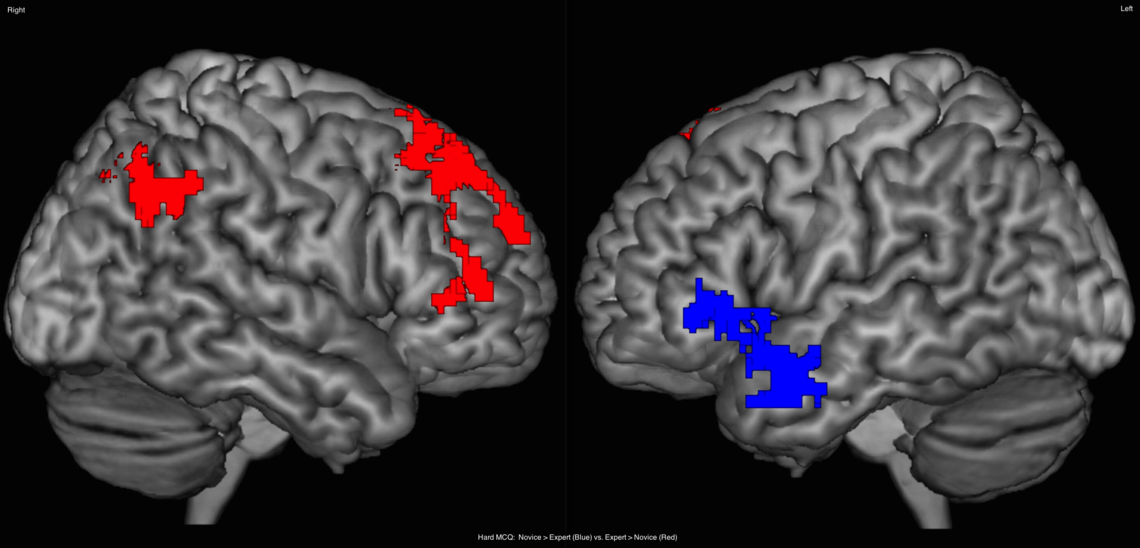Jan. 7, 2016
Brain imaging helps researchers see how physicians make decisions

Using fMRI, blue areas show activated areas in novices while red indicate areas for experts.
Have you ever wondered what’s going on inside your brain when you are struggling to learn something, reasoning through a problem, or trying to make an important decision? Well, you are not alone.
Researchers continue to search for ways to unlock the mysteries of these cognitive processes, and some are now using brain imaging — functional magnetic resonance imaging (fMRI) — to understand how we process thoughts during real-life experiences.
In a recent study conducted at the University of Calgary, researchers used fMRIs to explore if novices and expert physicians use their brains differently from one another during clinical reasoning and decision-making activities. In the future, this could be used to personalize learning experiences, or to design education curricula to enhance the learning experience — providing both students and physicians with the knowledge they need, when they need it most.
Decision-making progresses from foundational knowledge to experience in clinicians
Pam Hruska, a clinical nurse specialist for Adult Critical Care in Alberta Health Services and a master student in Community Health Sciences at the Cumming School of Medicine, was lead author of the study. Under the supervision of Kent Hecker, PhD, she worked with an interdisciplinary team from across Canada to explore the neurocognitive processes underlying clinical reasoning and decision-making.
“As clinicians progress from novice to expert, research indicates decision-making becomes less dependent on foundational biomedical knowledge and instead relies more heavily on previous experience,” says Hruska.
“In this study, we investigated how differences in clinical case difficulty (easy and hard clinical cases) and physician level of experience impacted areas of activation in the brain.”

Scans show the difference in right and left hemisphere activation in novice and expert brains.
- Above: Scans show the difference in right and left hemisphere activation in novice and expert brains during clinical decision-making. Top left and right, the novice brain processing easy cases (blue), hard cases (red) and common areas of activation on easy and hard (purple). Bottom left and right show the expert brain processing the same cases.
Functional MRI show novices activate left hemisphere of brain while experts activate right side
By using functional MRI, the researchers showed differences in activation between hemispheres of the brain on hard clinical cases during decision-making tasks. Novices activated areas in the left hemisphere, associated with semantic ability (fact-based knowledge), while experts activated right hemispheric areas associated with abstract knowledge (experiential knowledge).
“Physicians depend on clinical reasoning and decision-making skills in order to care for patients safely and effectively. This study has now shown neuro-functional differences in the brain between novices and experts, which are concordant with previous problem-solving theories,” says Dr. Sylvain Coderre, associate dean, Undergraduate Medical Education.
Findings can help improve medical training and curriculum to reinforce learned knowledge
“This research has important implications for learning, especially regarding how we acquire new knowledge, store it in memory, and retrieve it when needed,” says Hecker, associate professor in Cumming School of Medicine and Faculty of Veterinary Medicine, and a member in the O’Brien Institute for Public Health.
“The goal now is to use this information to build a curriculum that effectively reinforces learned knowledge in combination with experiential learning through repeated exposure,” says Hruska. “By doing so, educators can be more specific with how they develop physicians to become expert diagnosticians over the course of medical training, in order to provide even better care for patients.”
Led by the Hotchkiss Brain Institute, Brain and Mental Health is one of six strategic research themes guiding the University of Calgary toward its Eyes High goals.
